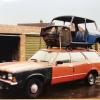Good Afternoon All,
I'm sure somewhere in the archive a similar question has been asked in a different way but I haven't been able to locate such information so please humour me.
I'm planning on building a custom wiring loom for my mini for a number of reasons mostly because the loom currently fitted has seen better days, had cables replaced so the loom colours do not match that of any wiring diagram completely and also because the car doesn't have many electrical components even by a mini standard so spending £500+ on a new loom where half of it would be disconnected seems rather large waste of money.
Now I get building a custom loom isn't as simple as writing it down, and I understand there will be comments about different current draws, volt drops, measurements and everything else however with this in mind I'm still going to attempt it. I have a good understanding of circuitry in general and electrical diagrams so I am content it is within my skillset. I also have close friends who are radar and/or avionic engineers by trade so electrical understandings and cabling is kind of covered from their end but its not hand in had with automotive and we had a discussion I was hoping someone here might be able to clarify.
So here is my question:
The below part of a wiring diagram ripped from the forum was most helpful but also led to how the battery recharged and how the system doesn't burn itself out. Now to better understand how to set up my loom I first wanted to clarify why exactly the smaller rated cables connected from the starter solenoid do not overheat and combust.
The main battery cable connects to the solenoid which in turn connects to the Alternator, Ignition Switch, Starter Motor & the No charge warning lamp. When the engine is up and running the alternator should be providing 45Amps of power at around 13.5-14V thus keeping the battery charged. Some of this power will be drawn by things plugged in so will likely be less but how is it that the cables connected to the solenoid at a common connection, which are a small gauge wire not designed for such current not burn out or get damaged?
Is it that the electricity generated will take the path of least resistance which is back down the battery cable to recharge and the smaller draw required on cables leading to either fuses or ignition only draw the required and the excess its travelling to the battery?

I feel I have waffled a little trying to explain my question however that's how my mechanical brain works. Any information provided will be of great help and value among a spirited debate of friends and the designing of a wiring loom intended to not combust in use.
Thanks in advanced




















